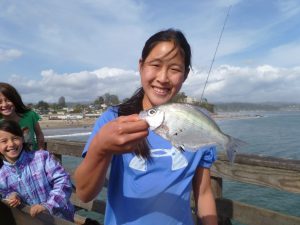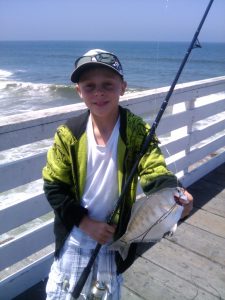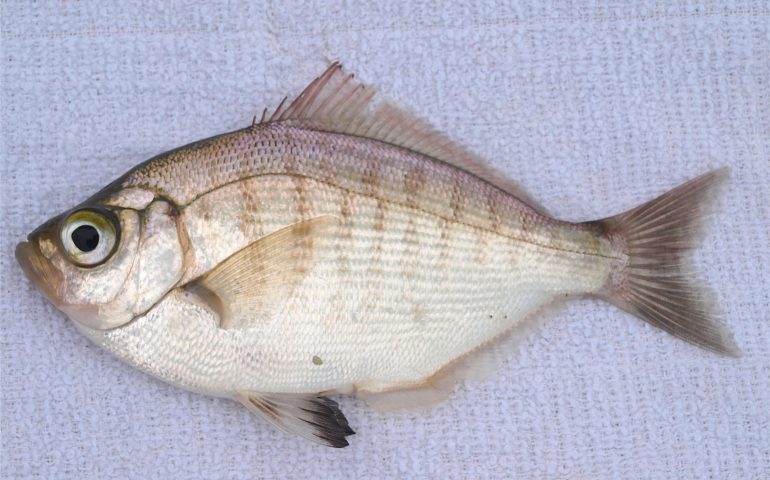Surfperches/Seaperches: Family Embiotocidae
Species: Hyperprosopon argenteum (Gibbons, 1854); from the Greek root words hyper (above) and prosopon (face, from the upward direction of the face) and the Latin word argenteum (silvery). Family Embiotocidae, subfamily Amphistichinae.
Alternate Names: Silver perch, white perch, surf fish, bigeye perch, and China pompano. In Mexico called mojarra ojona or perca. Occasionally called wally perch, probably by those who have watched too many Leave It To Beaver reruns.
Identification: Typical perch shape. Identified by the tips of the pelvic fins being black and their very large eyes. Their coloring is silver with some duskiness on the back. Can have bars or no bars on their sides.
Size: To 12 inches; most caught from piers are less than 10 inches. Fish caught in northern California tend to be larger than those caught in the south.
Range: Punta San Rosarito and Isla Cedros, central Baja California, to Willapa Bay, Washington. Common from Bahia Playa Maria, central Baja California, to Oregon.
Habitat: In shallow-water areas, near both sand and rocks. Common in both oceanfront areas (throughout the year), and in bays (primarily during the summer). Often found in dense schools consisting of several hundred fish. They’re considered a nocturnal species that feeds mostly at night (although I’ve never had a problem catching them during the day.
Piers: Walleye are one of the main catches at almost every oceanfront pier in the state but larger concentrations seem to exist in the north. Best bets: Crystal Pier, Seal Beach Pier, Malibu Pier, Gaviota Pier, Pismo Beach Pier, Avila Pier, San Simeon Pier, Seacliff Pier, Pacifica Pier, Fort Point Pier, Elephant Rock Pier, Fort Baker Pier, Point Arena Pier, and the Commercial Street Dock in Eureka.

Walleye surfperch from the Capitola Wharf
Shoreline: One of the main fish for sandy shore anglers in California.
Boats: An inshore species rarely taken by boaters.
Bait and Tackle: Tackle can be kept light. Best bet is to rig a modified snag line, three or four size 8 hooks, each baited with a very small strip of anchovy and a 1/2-to 1-ounce sinker. Cast the rig out, let it sink to the bottom, then begin a slow retrieve; the walleye surfperch will often follow it from the bottom to mid-depth range and hit it on the way up. Many, many times I have seen anglers trying to catch these fish but failing simply because their bait or rigging was too large; walleyes have small mouths and will peck away at larger baits but not be hooked. Walleye will eat shrimp, mussels, worms, squid and pieces of fish, but small strips of anchovy have proven to be the main winner in my experiences.
Food Value: Mild-flavored flesh with small flakes and a soft texture. The flesh is white colored and low in fat content. Can be cooked in any manner but most commonly fried. Many walleye are really too small to have much meat available but can be cooked whole.
Comments: This fish numerically ranks first among the fish I have caught at California’s piers. In the Department of Fish & Game studies, it ranked fourth among all pier-caught fish in southern California, and third among fish in central and northern California.
Of note was a study done by the Department of Fish and Game in the Bolsa Chica-Hermosa Beach area between 2007 and 2009. Walleye surfperch ranked fourth among surf fish collected in the study and showed an increase in numbers from the 1990s.

Walleye surfperch from the Crystal Pier in San Diego

Cabrillo Pier in San Pedro is also a great pier for walleyes, just thought I should put that out there.
Thank you for this insightful article! Your unique perspective and clear examples have transformed my understanding of the topic. Looking forward to more of your work!
Steam or poach, flake the meat off, make fish cakes. I use a crab cake recipe and use panko for the crumbs instead of crackers.
Steam whole fish chinese style. you love taste.
Grilled fish tastes good.
What’s the name of this fish?
Fish with rice or chips is a great combination to eat.
I love fishing, but the nearest river to my home is 200 miles away.